

Aeolus. Aeolus Aeolus[1] (/iːˈoʊləs/; Ancient Greek: Αἴολος, Aiolos [a͜ɪ́olos], Modern Greek: [ˈe.o.los] ( )), a name shared by three mythical characters, was the ruler of the winds in Greek mythology.
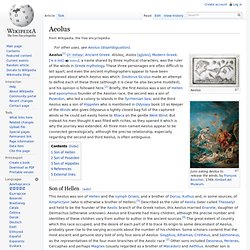
These three personages are often difficult to tell apart, and even the ancient mythographers appear to have been perplexed about which Aeolus was which. Diodorus Siculus made an attempt to define each of these three (although it is clear he also became muddled), and his opinion is followed here.[2] Briefly, the first Aeolus was a son of Hellen and eponymous founder of the Aeolian race; the second was a son of Poseidon, who led a colony to islands in the Tyrrhenian Sea; and the third Aeolus was a son of Hippotes who is mentioned in Odyssey book 10 as Keeper of the Winds who gives Odysseus a tightly closed bag full of the captured winds so he could sail easily home to Ithaca on the gentle West Wind.
Anemoi. Wind rose as known in ancient Greece, created by the scholar Adamantios Korais around 1796 In ancient Greek religion and myth, the Anemoi (Greek: Ἄνεμοι, "Winds")[n 1] were Greek wind gods who were each ascribed a cardinal direction from which their respective winds came (see Classical compass winds), and were each associated with various seasons and weather conditions.

They were sometimes represented as mere gusts of wind, at other times were personified as winged men, and at still other times were depicted as horses kept in the stables of the storm god Aeolus, who provided Odysseus with the Anemoi in the Odyssey. Aos Sí. Some secondary and tertiary sources including well-known and influential authors such as W.B. Yeats refer to aos sí simply as "the sídhe" (lit.: mounds).[1] In Gaelic mythology[edit] In Gaelic folklore[edit] In folk belief and practice, the aos sí are often appeased with offerings, and care is taken to avoid angering or insulting them.
Often they are not named directly, but rather spoken of as "The Good Neighbors", "The Fair Folk", or simply "The Folk". Aos sí are sometimes seen as fierce guardians of their abodes – whether a fairy hill, a fairy ring, a special tree (often a hawthorn) or a particular loch or wood. Aura (mythology) In Greek and Roman mythology, Aura is the divine personification of the breeze.
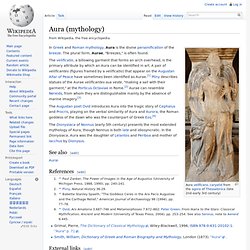
The plural form, Aurae, "Breezes," is often found. The velificatio, a billowing garment that forms an arch overhead, is the primary attribute by which an Aura can be identified in art. A pair of velificantes (figures framed by a velificatio) that appear on the Augustan Altar of Peace have sometimes been identified as Aurae.[1] Pliny describes statues of the Aurae velificantes sua veste, "making a sail with their garment," at the Porticus Octaviae in Rome.[2] Aurae can resemble Nereids, from whom they are distinguishable mainly by the absence of marine imagery.[3] The Dionysiaca of Nonnus (early 5th century) presents the most extended mythology of Aura, though Nonnus is both late and idiosyncratic. Aurai. See also[edit] References[edit] Jump up ^ AURAE : Nymphs of the breezes ; Greek mythology ; pictures : AURAI.
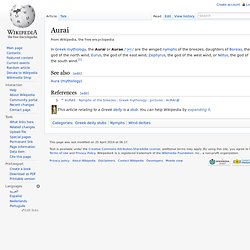
Cardea. Cardea and doorways[edit] Allegorical depiction of the Four Seasons (Horae) and smaller attendant figures that flank a Roman double-doorway representing the entrance to the afterlife,[4] on a mid-3rd century AD sarcophagus Stefan Weinstock conjectured that these three doorway deities had a place in cosmology as the Ianitores terrestres, "doorkeepers of the earth," guarding the passage to the earthly sphere.
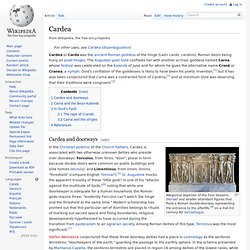
Dáinn, Dvalinn, Duneyrr and Duraþrór. This drawing made by a 17th-century Icelander shows the four stags on the World Tree.
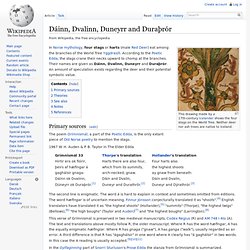
Neither deer nor ash trees are native to Iceland. In Norse mythology, four stags or harts (male Red Deer) eat among the branches of the World Tree Yggdrasill. According to the Poetic Edda, the stags crane their necks upward to chomp at the branches. Their names are given as Dáinn, Dvalinn, Duneyrr and Duraþrór. An amount of speculation exists regarding the deer and their potential symbolic value. Primary sources[edit]
Norðri, Suðri, Austri and Vestri. In Norse mythology, Norðri, Suðri, Austri and Vestri ("Northern, Southern, Eastern and Western") are four dwarves in the Prose Edda book Gylfaginning who each support one of the four cardinal points.

Together, they uphold the heavenly dome, created from the skull of the jötunn Ymir. They probably represent the four winds,[1] corresponding to the four stags of the cosmic tree Yggdrasill.[2] Compare the four gods who personify the winds in Greek mythology. See also[edit] Notes[edit] Jump up ^ Jacob Grim & James Steven Stallybrass, Teutonic Mythology, 2004, vol. 2, p. 631.Jump up ^ Finnur Magnússon, Eddalæren og dens oprindelse, 1824, p. 144.
Njörðr. Stribog.